My Ideal Garage Set-up
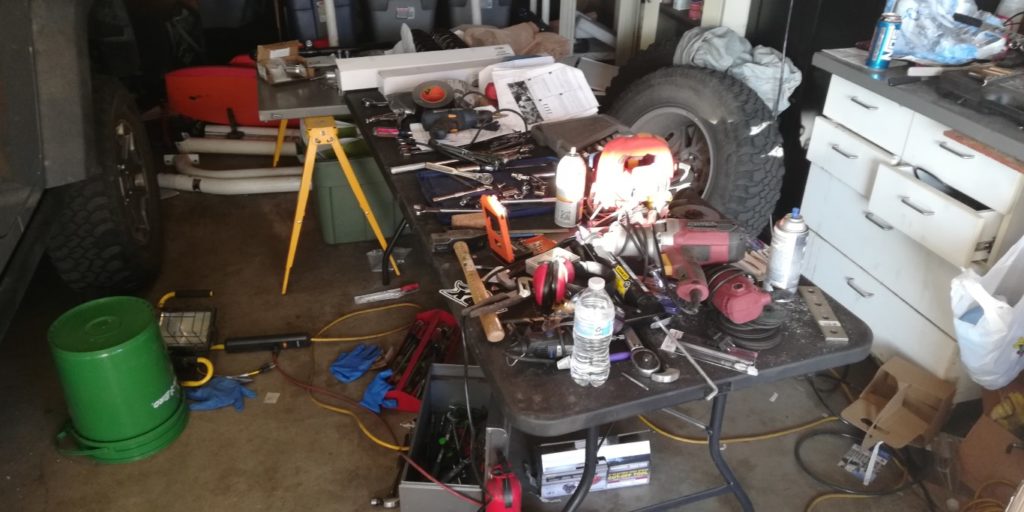
Okay, so maybe that’s not the best picture to define “ideal”, but it is real. That’s what it looks like when you’re installing a Teraflex lift on your Jeep, mostly by yourself and mostly after work into the wee hours.
I’m helping a friend do a mechanic’s upgrade to their garage to help with wrenching on various vehicles and created the below list of what I’d want to upgrade to for a consumer/prosumer level garage. What struck me is I actually have a majority of these items, some exactly as below, some hand-me-downs, and some lesser components because money is always an object. Some of these are what I’d buy if I could based on the confluence of price and quality, some I already own. I’ll keep adding tools as I think of them as I know I’m missing quite a few. I’m reminded of Gran Torino where Walt gives Thao duct tape, WD-40 and Vice Grips for his first tools. Thao complains that he can’t afford so many tools but Walt notes he acquired them over 50 years. I’m not there yet but it is interesting how things accumulate over time. I’m still using the Craftsman toolbox and box-end wrenches my dad bought me when I was in college, has to start somewhere. (Also, WTH??!?! I was looking for a link to the toolbox and the only way I found it was under “Vintage“? That is so wrong. The tool box below is what I have, this toolbox is the closest comparison I can really find. Vintage. Son of a…)
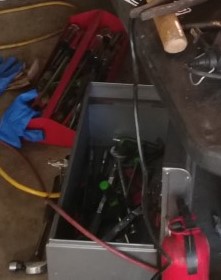
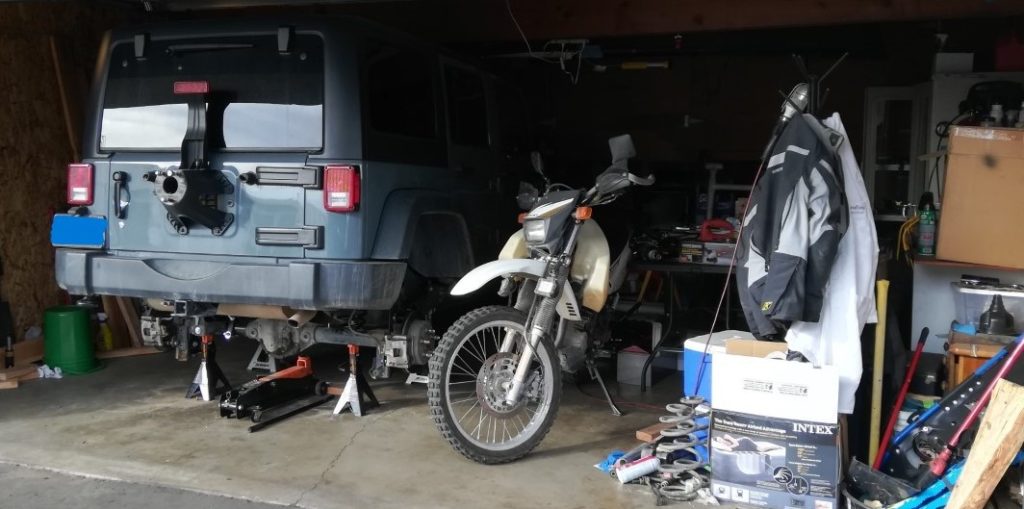
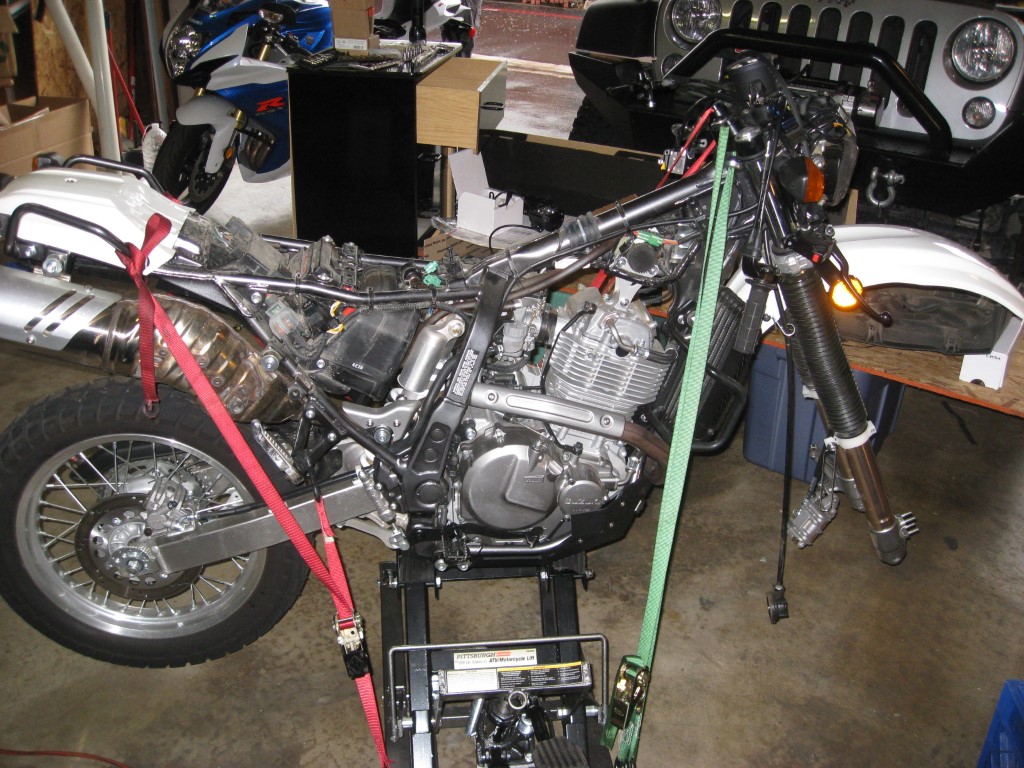
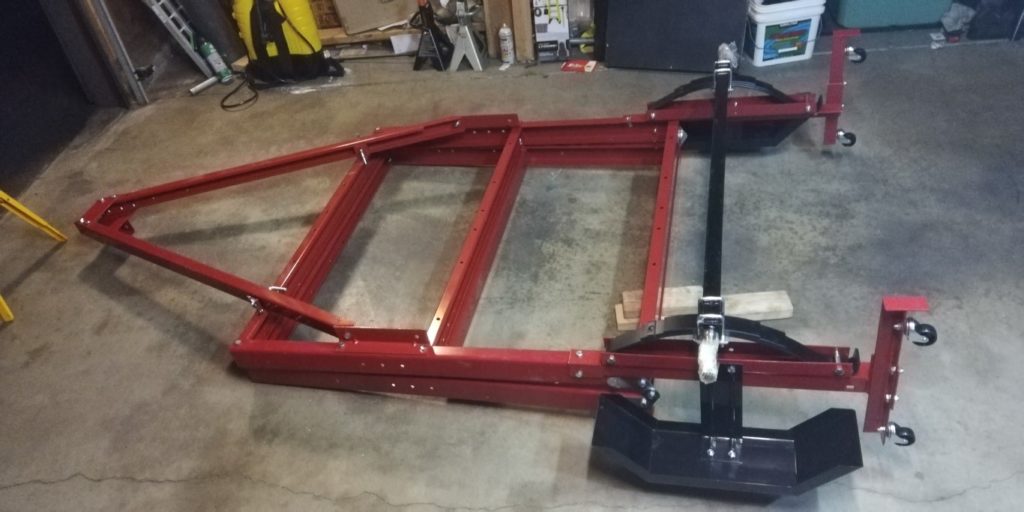
I work on mostly vehicles, motorcycles, trailers, with a little woodworking tossed in for good measure, as you can see in some of the pictures below, and I know what it feels like to be working on your vehicle at 1am on a weeknight and the separation from sanity which naturally thereby occurs:

My (attainable) Ideal Garage:
Makita Mac5200 Air Compressor: Regular plug-and-play power, good HP, portable, oiled, affordable, 6.5 CFM is big enough for general work with some breaks.
Ingersoll-Rand 60 gallon or Dewalt 60 gallon or North Start Electric. Home Depot also has a Husky version: Will require some install efforts such as concrete bolts and wiring, 60 gallon gives good air-flow and higher power refills more quickly running 12+ CFM at 90+psi. 2-3x the expense of smaller options but much higher productivity.
Talking about air compressors is like talking religion and politics and it rarely ends well. First, like everything these days half of what’s out there is rebranded Chineseium with misleading psi and HP numbers (do you really think the Porter Cable pancake I bought is any different than the Craftsman version?) Second, you need to be positive what work you’ll actually be doing, with which exact tools, how many of those tools and for how long at any given time, which determine the size of tank and pump you need, in terms of (S)CFM and gallons. Lastly, what are your power and space constraints? Is this a bolt-to-the-concrete permanent installation running 240 or 480 voltage or just plug and play 110V? This is before even getting into duty cycle, single vs 3-phase, oiled vs oil-free, oil-contamination, and other mind-numbing considerations.
But since you’re probably not concerned with rotary vane compressors and the difference between CFM and SCFM, you likely just need something to spin up that impact wrench so this can be simplified a bit. First, just know that your home 110V/15amp (~20amp max) circuits can’t push out more than a few hp. I think 5hp at 110V requires 34 amps in perfect conditions, so it’s not happening, ignore the hype. Second, look at your tools or the tools you want to purchase. Are you running four impacts at once for minutes at a time or are you running mostly one air-intensive tool with time in-between uses? More likely the latter. Read the tool, see what the PSI/CFM stats are and then look for compressors which meet those specs. Get the biggest tank you can and go from there.
The Makita noted above is a compromise in terms of reasonable cost, regular voltage, and sustainable 6.5 CFM which is good enough for consistent home use, and it can be tucked away in a corner when not used. However, it may not be big enough for the plasma cutting, vehicle painting, sanding use case for my friend, in which case I added some other recommendations. Note that for the oiled and 240V variety you’ll need to add the cost of oil, permanent installation, rewiring wall plugs and potentially even purchasing the wiring itself. Go with the best you can afford but only for what you really need.
I’ve rewired much of my motorcycle and a few things on my Jeep with great success. Combined with quality connectors these have proven to work for me. Note that I prefer crimping to soldering in high vibration and weather environments since soldering tends to be more brittle and requires more effort to protect. Not that one is better than the other, they both have their utility, I just find crimping to be the better option for my typical use-case (and skill).
At home I’m still using the cheapo Harbor Freight version and it does the job just fine, has been working for years. However, it only has two settings – hot and hotter – and has no cool down function or any integral design to keep the hot nozzle off the ground. Not a big deal on cement, very big deal on plastic or wood tables or around cardboard or other melty/flammable items. I used the Wagner at work and I liked the variable temperature (fan) settings but especially both the ability to set it down securely on a table with the tip facing up and the cool-down function.
The cheapo versions you get at the auto shop or HF work fine for unimportant purposes but when you ride a dual-sport thumper on knobbies off road, they just don’t cut it. I’ve had great success with these, they shrink nicely and are long enough for that shrinkage to actually hold-on to the wire. I tend to run shrink tube over these but probably don’t need to.
I rewired the battery terminals on my Jeep to install Vgate Terminals and used these since I couldn’t find a mechanic to do it for me. Haven’t had any issues in almost 4 years so both the terminals and the connections are still holding up. Longer than the factory Jeep batteries did, so that’s nifty.
Socket/Wrench set:
Option 1:
Craftsman 450 piece +Ratcheting Metric + Ratcheting SAE + Female Torx + Spark Plug Sockets
Option 2:
I use this and the inch pounds version which is necessary for motorcycle components.
Reducer/Increaser Socket Adapters
I currently only have the largest of these and multiple lengths of pipe, up to a 4′ destroyer tube for when I hulk out. But they are handy and better to use than over-torqueing your ratchets.
Never underestimate a BFE. Ball joints, propane torch, BFE, bad language. Those who know will understand.
Full disclosure, I purchased a basic Dewalt Miter Saw and a cut off wheel for some accurate metal cutting I needed to do since I needed the ability to cut wood and metal in one tool. Severe compromise, although it worked relatively okay. Price being no object I’d buy the cut-off wheel and a compound miter saw.
Angle Grinder: Either/both corded/cordless Metabo HPT 5″ and/or Milwaukee M18 Fuel
Milwaukee M18 Fuel Impact Driver
Why on earth would anyone still use corded drills, what are you, an idiot? I’ll own being an idiot, but there’s a case for corded drills:
- Cheaper. This is a good drill and it’s less than $100 at the time of this writing. Typical cordless with two batteries and a charger is double that.
- Lighter. No battery pack to weigh you down.
- Smaller. Again, no battery pack required.
- More powerful. This Dewalt isn’t likely much more powerful than a high-end cordless but it’s definitely more-so than cheaper options. Heavy duty tasks like concrete still see corded on top.
- Higher speed. Sometimes higher speed is more important than high torque.
- Non-stop power. As long as you have electricity you have power, no need to recharge.
The cons are obvious and if I could only afford one type I’d go high-end cordless like the M18 Milwaukee and just build up around that universe. But then again, I now have an M12 & M18 driver and I still sometimes use my 25 year old beat-up blue (not green) Ryobi. We’ve seen some things, me and that drill. Buy both, use both, in my opinion.
I use this currently, it does the job well and has nice spots for every accessory so I don’t lose them. No stupid bags.
I stand fairly tall and my back hurts leaning over most tables. This is heavy duty, wood can be bolted into more readily than steel and I can adjust it high.
Same height adjustment as the wood top but steel has benefits because you can just beat the crap out of it and not really care. Don’t have to worry about water or glues or whatnot.
Locking Storage Cabinet: Ideally welded with windows (I lucked into two of these used and they’re a game changer but are expensive), next ideal welded no windows but also expensive. If necessary, flat pack assembly required, which is much cheaper but not as durable. Other options are plastic yard/garage cabinets, unknown solvent resistance as compared to metal: Sterilite, Rubbermaid.
Oil, spill kit, cleanup cabinet: Something enclosed, can accept or act as secondary containment, easy to clean. Some options include Patio storage, locking storage cabinets per above.
I’m still using a hand-me-down from my Grandpa (Rest in Peace) but this is what I was looking into before I was gifted mine.
Motorcycle Lift (that super wide base is perfect for axles, bumpers, winches, skidplates, etc. Surprisingly useful tool)
Belt Sander: This isn’t the best or most heavy duty but it gets the jobs done. Can always upgrade to something fancier should it be required.
Bench Grinder Stand: Would be nice not to keep putting my grinder on the workbench.
Universal Tool Stand & Mobile Base: I have several tools which I don’t like using on the workbench but which require heavy-duty bases, such as my belt sander below. Could also put a portable lathe or similar on it just fine. At 32″ tall it’s not as high as I’d normally like but the equipment itself will add height and with a 500# capacity it’ll do the job. It’s not designed to be used with casters, mostly likely for stability purposes, but mobile bases such as noted above add mobility while keeping the stability.





